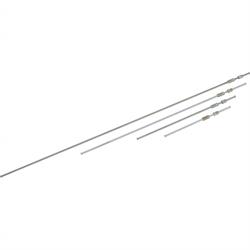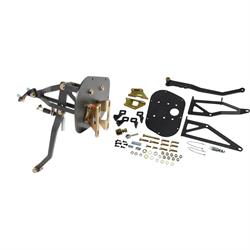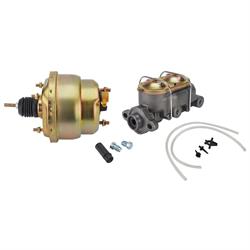Effects of Master Cylinder Bore Size on Your Brake System
Today we are going to discuss master cylinder bore size and their affect on your brake system. Previously we have installed a Speedway front and rear disc brake conversion on a '54 Bel Air along with a firewall mount pedal assembly and 7-inch booster/master cylinder combination. To start off we chose a 1-inch bore master cylinder in the combo to maximize pressure and still keep the volume required for a disc brake system. This worked okay, but we still had a lot of pedal travel before the brakes would actually lock up.
What Size Master Cylinder Bore Do I Need?
On our setup we are using the larger piston GM midsize calipers in the front and the smaller piston GM metric calipers in the rear. Armed with the following information: brake pedal ratio of 5.75:1, master cylinder bore size of 1-inch, and front caliper bore size of 2.75-inch, we can use a formula to determine if our pedal ratio is correct for the size of the master cylinder we are using. This can get very confusing since you need to know the bore area instead of the bore size, which is a diameter measurement. There is a series of equations to go through to figure this out, but to simplify this we have created a nice conversion chart showing the bore area for several popular bore sizes of master cylinders and calipers. Keep in mind, if using a multiple piston caliper you need to add together the piston area of all the pistons in one caliper.
The midsize GM caliper we are using on the front has a 2.75-inch bore piston, which equals 5.94 in² area according to the chart above. The 1-inch bore master cylinder we currently have has an area of 0.79 in². To determine the correct pedal ratio you would divide the caliper piston area, which is 5.94 in², by the master cylinder area of 0.79 in², which equals 7.52. This would mean we would need an effective pedal ratio of 7.52:1 for optimal performance with a 1-inch bore master cylinder. This is far from the 5.75:1 ratio we have in our car already. So, instead of changing the brake pedal ratio we chose to change the bore size of the master cylinder to 1-1/8-inch (1.12-inch) which as an area of 0.99 in². Doing the math with this combination, 5.94 / 0.99 = 6, which equals a 6:1 pedal ratio. So with the 1-1/8-inch bore master cylinder we will be right where we need to be for proper brake pedal travel.
How do I Measure Pedal Ratio?
If you don't know what your pedal ratio is this can be figured out with some measuring and a little math as well. To determine pedal ratio you need to know the distance from the center of the pivot point (where the brake pedal arm mounts) to the center of the push point (brake pedal pad), call this measurement "A" for reference in the diagram. Then measure the distance from the center of the pivot point to the center of the push point for the master cylinder, reference letter "B". Then you divide the "A" measurement by the "B" measurement to get your brake pedal ratio.
Installing a Master Cylinder
After doing the math we ended up changing the master cylinder to Speedway Motors part number 91031440, Power/Manual Master Cylinder which is a 1-1/8-inch bore size. We installed the supplied plunger slug in the master cylinder since we are using it with a brake booster. If using this master cylinder with a manual pedal that has no booster then the plunger slug will not be used.
This slug needs to be installed for power brakes and you may need to adjust the brake booster push rod once bolted together. There must be at least 1/32-inch of clearance between the master cylinder plunger and the booster pushrod. If there is not enough clearance it could result in your brakes dragging and building up a massive amount of heat.
We then bench bled the master cylinder until all the air was removed and installed it. At this time we added a line lock and flared all new 3/16-inch hard lines as well so we had already planned to bleed the entire system.
What's the Difference Between Brake Fluid Volume and Pressure?
So, to help simplify all this, a larger bore master cylinder will displace a larger volume of fluid, but will result in less fluid pressure with the same pedal effort. The opposite is true for a smaller bore master cylinder. A smaller bore master cylinder will create more pressure with the same amount of pedal effort but it will displace a smaller volume of fluid. The math added up and the 1-1/8-inch master cylinder worked out perfectly on our old '54 Bel Air with large bore front calipers and a power brake booster.







